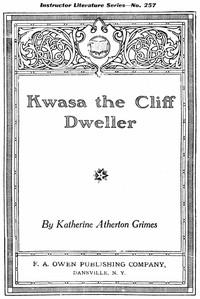|
|
Read this ebook for free! No credit card needed, absolutely nothing to pay.Words: 56676 in 25 pages
This is an ebook sharing website. You can read the uploaded ebooks for free here. No credit cards needed, nothing to pay. If you want to own a digital copy of the ebook, or want to read offline with your favorite ebook-reader, then you can choose to buy and download the ebook. CHAP. PAGE PREFACE 7 INDEX 93 The Cupbearer " 39 Polychrome Cups " 62 Mr. Veniselos was brought up in Crete. It is not the first time in history that Crete has passed on her products to Greece and to Europe. Four thousand years ago the very foundations of Greek and of European civilization were laid in Crete, which was then mistress of the sea and the dominant factor in the AEgean. Yet we none of us were aware of this until Sir Arthur Evans, a few years ago, began digging in Crete. When Mr. Veniselos was a boy the very existence of a prehistoric Cretan civilization was unknown. Our knowledge of it has been almost entirely revealed since 1900. In this short time the spades of Sir Arthur Evans have revolutionized our whole conception of the early history of Europe. Excavation at Knossos, Phaestos and other sites in Crete has disclosed the existence of a people whose form of civilization, the earliest in Europe, flourished long before recorded history begins. It has told us about their daily life, games, amusements, art, religion, writing ; their physical type, dress, the homes they lived in. The fashion of the women's dresses, as revealed on ornaments and other art relics, with an open neck and flounced skirts, made a French scholar exclaim: "Mais ce sont des Parisiennes!" A big palace, as big as Buckingham Palace, has been unearthed at Knossos. It has a drainage system which an eminent Italian archaeologist, Dr. Halbherr, has described as "absolutely English," and which certainly forestalls the hydraulic engineering of the nineteenth century. This four thousand years ago. The digging in Crete has created all the excitement of exploration. When the painted panel was discovered giving a sensational bull-baiting scene from a Minoan circus-show, or the Phaestos disc covered with picture writing, or the fresco painting of the Cupbearer at Knossos, the excitement reached its height. It was not confined to the excavators. An old workman who was on night duty watching the Cupbearer fresco during the delicate operation of its removal, was woke up by disturbing dreams and declared after that "The whole place was full of ghosts." Up to the last half-century the whole story of classical Greece, as taught in the schools and in the Universities, was regarded as something original, as the beginning of things springing suddenly, like the mythical Athene, into life. The sculpture, architecture, philosophy, oratory, and drama of the fifth century B.C., were accepted unquestioningly and with awe as the spontaneous first-fruits of Greek genius. The history of Greece, as then understood, went back only to the eighth century B.C., beyond which were the Dark Ages and nothing. Before the time of AEschylus, Sophocles, and Euripides it is true there had been a problematic poet, half mythical, half real, elusive and shadowy, known as Homer. The fact that he was represented as having been born in nine separate places was an illustration of the vagueness in which the poet's identity was enveloped. He had sung of deeds and of men who seemed to echo from those Dark Ages. Whatever speculation there was as to Homer himself and his identity, no one ever doubted that if he was a real person he certainly was the first real person that European history could establish. During the last twenty years he has been shown to have been not the beginning but the end of an enormous phase of Greek and European history. Now that the real beginnings of Greek civilization are beginning to be known, it strikes one as remarkable that up to now they should have been so completely buried in two senses. It is the more remarkable because a good deal was known about other corresponding origins in the Near East. In Egypt and Babylonia the old traditions had been passed on by later generations to Greek writers, who preserved, imperfectly it is true, the necessary connecting links. In the case of Greek civilization not only were there no stepping-stones back to the corresponding phase; it did not even seem to occur to anybody that there had been such a phase. The unquestioning and complacent acceptance as myths of the epic stories which centred round Agamemnon and the Homeric heroes was never challenged up to the middle of the last century. The historian Grote, for instance, declared that "to analyse the fables and to elicit from them any trustworthy particular facts" would be "a fruitless attempt" . Such was the outlook of Grote's contemporaries. Then an important thing happened. A poor boy named Schliemann had been told these Greek fables by his father, and to his child's mind the stories appeared as literally true. One day a drunken miller came into the grocer's shop where he worked, and began to recite some lines of Homer. Schliemann was fascinated, and, so the story goes, spent all his spare cash in whisky wherewith to encourage the miller to repeat the lines again and again; and then prayed God that he might some day have the happiness of learning Greek himself. His literal faith in the "myths" remained with him, and he made up his mind to find the walls of Troy. Being poor he had to spend a lifetime of hard saving before he was in a position to put his faith to the test. Late in life, however, he had saved enough money for the purpose and went to Hissarlik, the spot in Asia Minor where the town of Troy was said to have stood. He began digging into the earth, and to his joy discovered the buried walls of a town. It was proved later that the walls he discovered belonged not to the Homeric city, as Schliemann naturally assumed, but to another city which had existed on the same site a thousand years earlier. He had dug within and throu to call me that, eh?omeric walls without discovering them. From Troy he went to Mycenae and Tiryns on the Greek mainland, and there discovered the visible relics of the Homeric stories centering on the Greek mainland. Schliemann's achievement was to establish the historical existence of the "Mycenaean civilization." We now know that this civilization flourished from about 1400 B.C. to 1100 B.C. It is a romantic story of the way in which Schliemann justified his simple faith in the historic background of the Homeric poems. Schliemann deserved the explorer's satisfaction which he enjoyed, and which manifested itself on one occasion when he sent a telegram to the King of the Hellenes announcing that he had found the tomb of Agamemnon at Mycenae. One wishes that it had been literally true, as Schliemann thought it was. In any case it was he who laid the foundations for the whole structure of modern prehistoric research in the Eastern Mediterranean. The most exciting and the most important part of that research has been the opening up of Crete. The Cretan discoveries of Sir Arthur Evans and other excavators, British, American and Italian, have proved that the Mycenaean culture revealed by Schliemann was itself a late and even decadent phase of a great Mediterranean civilization which had its centre in Crete. Free books android app tbrJar TBR JAR Read Free books online gutenberg More posts by @FreeBooks
: Kwasa the cliff dweller by Grimes Katharine Atherton Wilson L J Illustrator - Shoshoni Indians Juvenile literature@FreeBooksThu 08 Jun, 2023

: Hellflower by Smith George O George Oliver Rose William William F Illustrator - Science fiction; Man-woman relationships Fiction; Drug traffic Fiction; Space ships Fiction; Human-alien encounters Fiction; Drug addicts Fiction@FreeBooksThu 08 Jun, 2023
|
Terms of Use Stock Market News! © gutenberg.org.in2025 All Rights reserved.






